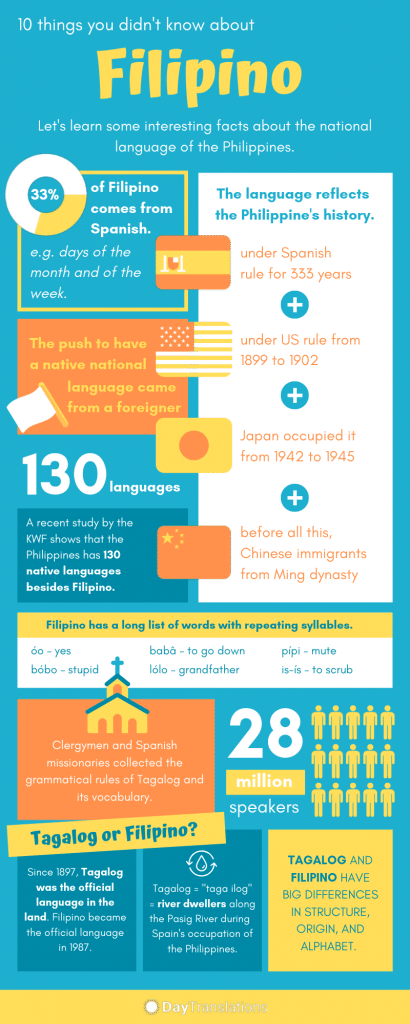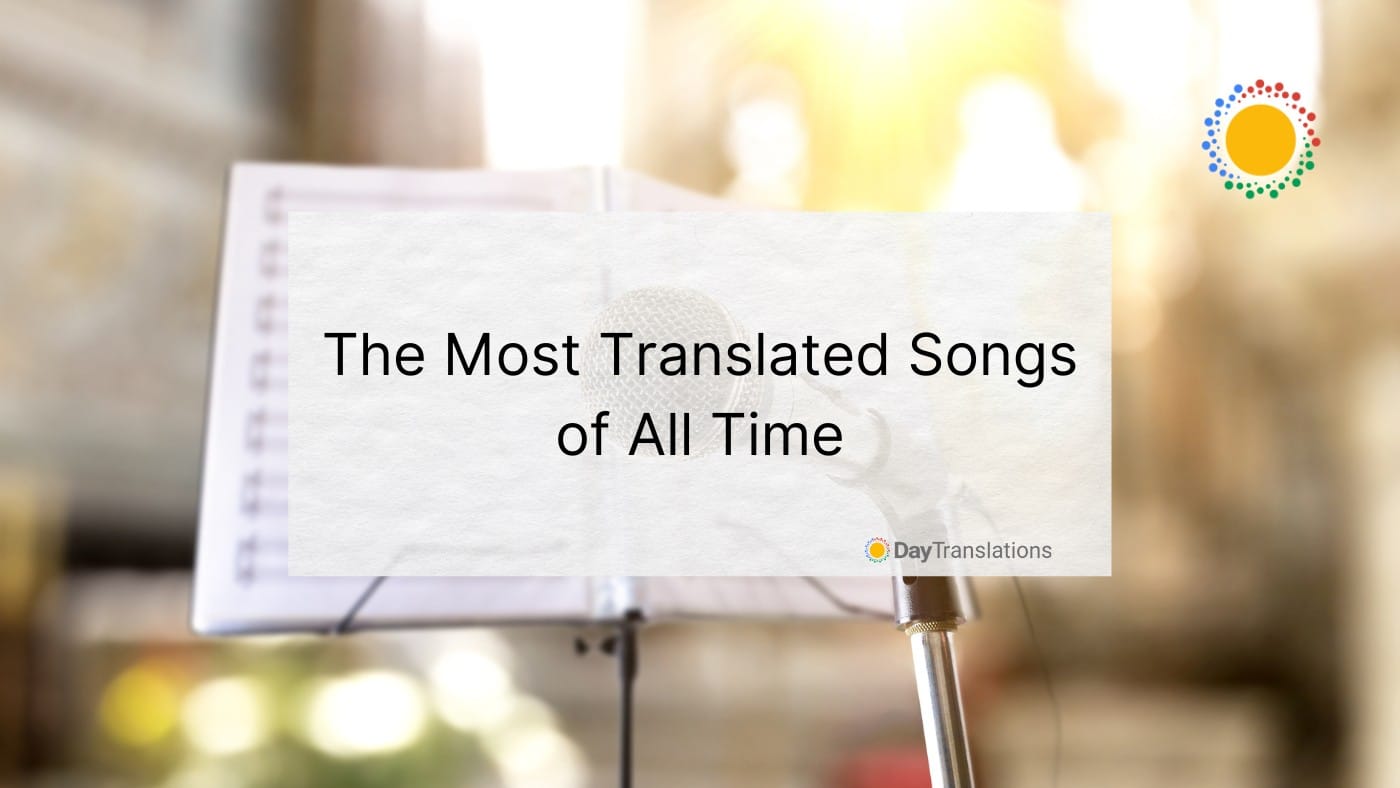The Philippines has two official languages, Filipino and English. Before anything else, it should be known that the Filipino language is the national language of the Philippines. A citizen of the Philippines is also called Filipino, although some use the term Pilipino from Pilipinas, the name of the country in the local language. Ethnologue on the other hand lists Tagalog as one of the principal languages of the Philippines together with Filipino and English.
The Philippines is a diverse country with several ethnic and immigrant communities. Right now, 183 languages and dialects are spoken in the country. Out of the estimated 2019 Philippine population of 108.2 million, 45 million speak Filipino.
Development of the Filipino Language
The development history of the Filipino language is complex. Officially, it is the standard version of Tagalog, the language spoken mostly in Luzon, the foremost island of the Philippines. Majority of the Filipino citizens are bilingual and multilingual.
To understand the development of Filipino as a language, one must know its origin. Tagalog is partly responsible for the emergence of Filipino, but it should be noted that in several key areas, the two languages are different.
The development of languages around the world is typically fascinating because several factors normally contribute to the formation of a language. The Filipino language is not a stranger to this fact. Many interesting factors as well as political and social developments occurred that helped the journey of the language from Tagalog to Filipino.
Facts About the Filipino Language
The Filipino language is a member of the Austronesia language family, which includes Malay, Māori and Hawaiian. It belongs to the subgroup of Malayo-Polynesian languages that are typically spoken by people in several island nations in the Pacific Ocean and Southeast Asia.
1. Since 1897, Tagalog was the official language in the land.
Filipino on the other hand became the official language in 1987. This is one of the reasons why many people, Filipinos, and foreigners alike, are confused as to which term to use for the language.
2. The term Tagalog came from ”taga ilog,” meaning the river dwellers along the Pasig River during Spain’s occupation of the Philippines.
Pasig River is a 25-kilometer river that connects Manila Bay and Laguna de Bay, dividing the city of Manila and its surrounding towns into southern and northern sections.
The term was difficult for the Spaniards to pronounce so it was reduced to ”tagalog,” the language, which became the basis of Filipino and other local languages. Aside from the original speakers of Tagalog who resided along the Pasig River, speakers of Tagalog were found in the provinces of Tarlac and Nueva Ecija, as well as in Quezon, Palawan, Mindoro, Romblon, Marinduque, and Batangas. All of these places are on the island of Luzon.
Some of the languages that were variations of Tagalog include Pangasinan, Zambal, Bikolano, Ilokano and Pampango (all spoken in Luzon) and Cebuano, Hiligaynon and Waray (spoken in the Visayas).
3. Tagalog and Filipino have distinct differences, such as:
· Structure. Tagalog’s vocabulary is more extensive than Filipino. It is stricter in the formation of sentence structures and includes several rules. The rules for Filipino are lesser, sentence structuring is simpler, and rules are more lenient.
· Origin. Tagalog is an ethnic language. Filipino, which stemmed from Tagalog, is a blend of eight language variants spoken in the country as well as Spanish, Chinese and English.
· Number of letters. Filipino has 28 letters, combining the 26 letters of the English alphabet plus NG and Ñ. Tagalog only has 27 letters as it does not have the letter Ñ. In the older version of Tagalog, however, there are only 20 letters: A, B, K, D, E, G, H, I, L, M, N, NG, O, P, R, S, T, U, W and Y.
4. In 1937, former Philippine president Manuel L. Quezon proclaimed Tagalog as the national language.
But what’s more interesting is that the push to have a native national language came from a foreigner. The call for a national language came ahead of the proclamation of President Quezon, which was supported by the Institute of National Language.
In 1924, a naturalized American citizen of Lebanese heritage named Najeeb Saleeby, suggested the institution of a national language, from one of the
languages spoken in the country. Saleeby was working in the Philippines to teach Filipinos about self-governance. He was against the use of English as the medium of instruction in the Philippines and pushed for Tagalog. According to him, it has more advantages over other local languages, since it is related to many Philippine heroes and used in the national capital, which at that time was Manila. However, the petition did not push through since many regional representatives were opposed to it. They wanted to maintain the use of Spanish and English as the official languages of the country.
5. The Filipino language serves to establish the identity of Filipinos.
The Philippines had been under several rulers. It was under Spanish rule for 333 years before it came under the rule of the Americans from 1899 to 1902. Japan occupied the Philippines from 1942 to 1945. But before all these three colonizers of the Philippines came, Chinese immigrants from the Ming dynasty were already in the Philippines. By the time the Spaniards settled, a significant number of Chinese Filipinos, called Sangleys, lived there.
Given these facts, you can see the Filipino people are of mixed heritage and do not have a specific identity. Thus, the Filipino language uniquely defines the Filipino identity.
6. The precursor of Filipino, the Tagalog language is not a pure language. It developed from various influences.
The early ancestors of the Filipinos were Negritos or Aetas from Asia who came to the Philippines through land bridges. They were small people with wide noses, black skin, thick lips, and slinky hair. Two types of Indonesians followed them. The first to arrive were tall, with thin lips, high noses, large foreheads, and light skin. The second wave of Indonesian immigrants were shorter, with darker skins, heavy jaws, thick lips and large noses. After the Indonesians, Malays migrated to the Philippines as well. It is one of the reasons why it is difficult to define the identity of the Filipino through physical looks, unlike the Chinese or Japanese.
These groups of people influenced the early development of the Tagalog language. Researchers found evidence of Bahasa Indonesia, Malay and even Sanskrit. They later replaced the language with Castilian Spanish. They used it as a medium of instruction for the elite, while the rest couldn’t learn Spanish. Later, Tagalog became peppered with loan words from Spanish as well as loan words from Chinese and English.
7. Lope K. Santos, a Filipino grammarian, writer and senator introduced the Abakada alphabet, adapted from the Latin alphabet.
It consisted of 20 letters and was officially adopted in 1940 to be used for the new national language, Filipino. The new language traces back to Tagalog. He published the Balarila ng Wikang Pambansa (Grammar of the National Language), the first local grammar book. They replaced it with the modern (28-letter) alphabet in 1987.
8. Spanish priests did most of the early studies on the Tagalog language. Clergymen and Spanish missionaries were the ones who collected the grammatical rules of the language and its vocabulary.
In 1613, Pedro de San Buena Ventura, a Franciscan priest published the “Vocabulario de la Lengua Tagala” (Vocabulary of the Tagalog Language), the first Spanish Tagalog dictionary. Today, it’s a very rare book. It receives regular editing, with the 2013 edition being the latest version.
9. About 33% of the Filipino word roots came from Spanish.
The Filipino names for the months of the year came from Spanish, i.e., Enero (Enero), Pebrero (Febrero), Marso (Marzo), Abril (Abril), Mayo (Mayo), Hunyo (Junio), Hulyo (Julio), Agosto (Agosto), Setyembre (Septiembre), Oktubre (Octubre), Nobyembre (Noviembre) and Disyembre (Diciembre). The same applies to the days of the week, namely, Lunes (Lunes), Martes (Martes), Miyerkoles (Miércoles), Huwebes (Jueves), Biyernes (Viernes) and Sabado (Sábado). Sunday is ”Domingo” in Spanish and many believe that the Filipino word for Sunday, which is “Linggo” is a shortened version of the Spanish term.
English is a prominent part of Filipino they use in everyday life. Many words appear as phonetic spellings of English terms, such as drayber (driver), basketbol (basketball), bistek (beefsteak), boksing (boxing), iskul (school), iskolar (scholar), cabinet (cabinet) and many more.
You’ll also find Filipino versions of Malay words, such as bilanggo (prisoner), from the Malay word belenggu, kanan (right) from kanan, kawal (soldier) from kawal, kulambo (mosquito net) from kelambu, etc. Filipino has several words derived from Sanskrit, Tamil, Persian, Arabic, Chinese, Japanese and even Nahuatl.
10. Filipino has a long list of words with repeating syllables. Here are some examples:
- chin or lowness – bábà
- to go down – babâ
- stupid – bóbo
- severity (of a condition) – lalâ
- grandfather – lólo
- a kind of gum made from the combination of betel leaf and Areca nut, with or without tobacco – ngángà
- to open your mouth – ngangá
- mute – pípi
- flattening something, a flattened thing – pipî
The Filipino language might be a tongue twister for some and many people seem to find it difficult to learn, maybe because of the influences from other languages. Still, Filipino is a fascinating language and learning a few Filipino phrases such as kumusta ka (how are you), magandang umaga (good morning), magandang tanghali (said at noontime), magandang hapon (good afternoon), magandang gabi (good evening) and salamat po (thank you), could be the icebreakers you need.
Need Accurate Translations?
If you’re looking for Filipino or Tagalog translation services, you’ve found the best place. Day Translations, Inc. has a team of native-speaking Filipino translators who live in-country. We can connect you to a translator to fit your requirements immediately. They are professional translators with years of experience behind them.
They understand the nuances of the language and have a deep knowledge of Filipino culture. With this in mind, rest assured that your translation project will be highly accurate.















Sorry, the comment form is closed at this time.